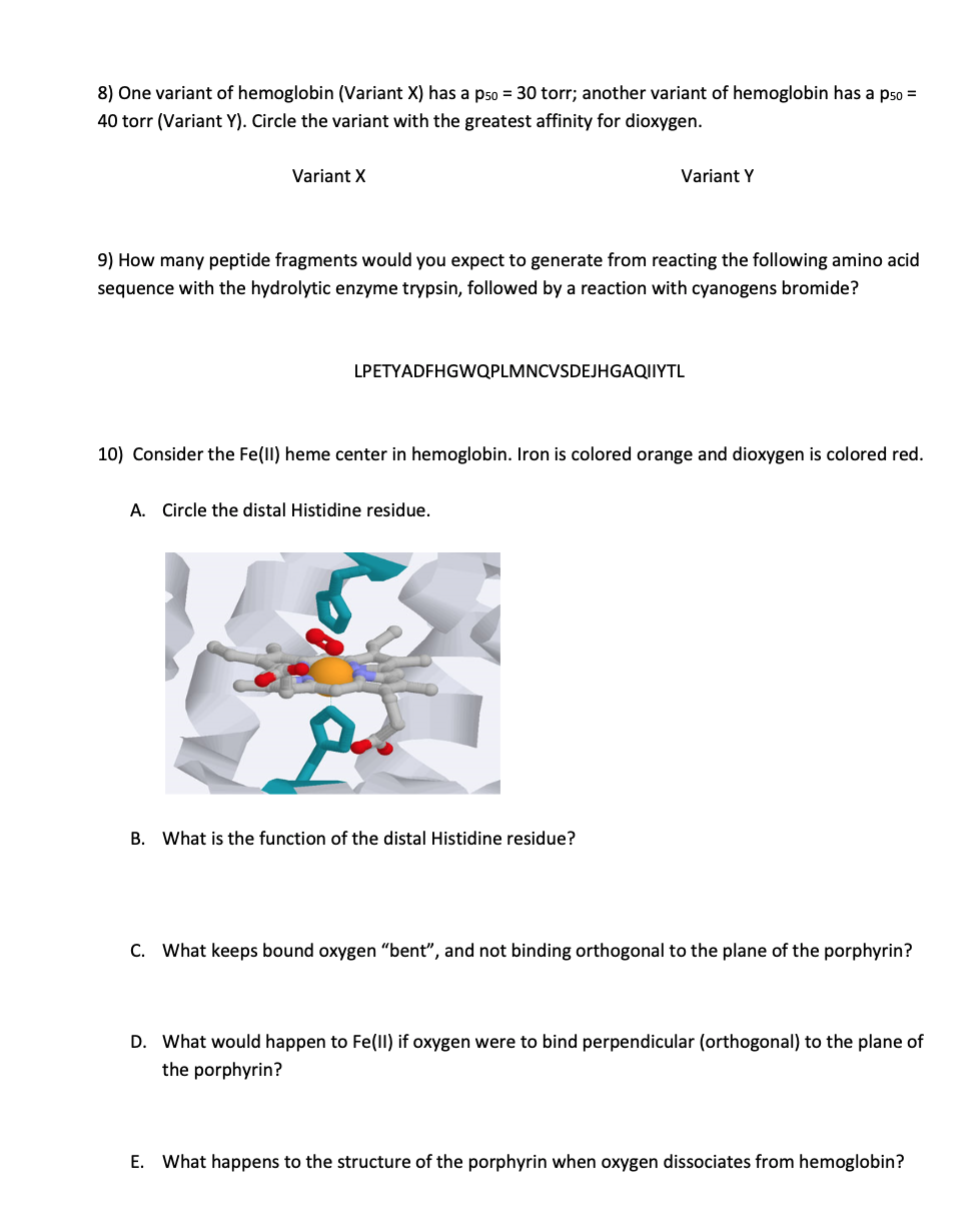8) One variant of hemoglobin (Variant X) has a pso = 30 torr; another variant of hemoglobin has a pso = 40 torr (Variant Y). Circle the variant with the greatest affinity for dioxygen. Variant X Variant Y
8) One variant of hemoglobin (Variant X) has a pso = 30 torr; another variant of hemoglobin has a pso = 40 torr (Variant Y). Circle the variant with the greatest affinity for dioxygen. Variant X Variant Y
Biochemistry
9th Edition
ISBN:9781319114671
Author:Lubert Stryer, Jeremy M. Berg, John L. Tymoczko, Gregory J. Gatto Jr.
Publisher:Lubert Stryer, Jeremy M. Berg, John L. Tymoczko, Gregory J. Gatto Jr.
Chapter1: Biochemistry: An Evolving Science
Section: Chapter Questions
Problem 1P
Related questions
Question
100%
Please answer all questions

Transcribed Image Text:8) One variant of hemoglobin (Variant X) has a pso = 30 torr; another variant of hemoglobin has a pso =
40 torr (Variant Y). Circle the variant with the greatest affinity for dioxygen.
Variant X
Variant Y
9) How many peptide fragments would you expect to generate from reacting the following amino acid
sequence with the hydrolytic enzyme trypsin, followed by a reaction with cyanogens bromide?
LPETYADFHGWQPLMNCVSDEJHGAQIIYTL
10) Consider the Fe(I) heme center in hemoglobin. Iron is colored orange and dioxygen is colored red.
A. Circle the distal Histidine residue.
B. What is the function of the distal Histidine residue?
C. What keeps bound oxygen “bent", and not binding orthogonal to the plane of the porphyrin?
D. What would happen to Fe(ll) if oxygen were to bind perpendicular (orthogonal) to the plane of
the porphyrin?
E. What happens to the structure of the porphyrin when oxygen dissociates from hemoglobin?
Expert Solution
This question has been solved!
Explore an expertly crafted, step-by-step solution for a thorough understanding of key concepts.
Step by step
Solved in 2 steps

Knowledge Booster
Learn more about
Need a deep-dive on the concept behind this application? Look no further. Learn more about this topic, biochemistry and related others by exploring similar questions and additional content below.Recommended textbooks for you

Biochemistry
Biochemistry
ISBN:
9781319114671
Author:
Lubert Stryer, Jeremy M. Berg, John L. Tymoczko, Gregory J. Gatto Jr.
Publisher:
W. H. Freeman

Lehninger Principles of Biochemistry
Biochemistry
ISBN:
9781464126116
Author:
David L. Nelson, Michael M. Cox
Publisher:
W. H. Freeman

Fundamentals of Biochemistry: Life at the Molecul…
Biochemistry
ISBN:
9781118918401
Author:
Donald Voet, Judith G. Voet, Charlotte W. Pratt
Publisher:
WILEY

Biochemistry
Biochemistry
ISBN:
9781319114671
Author:
Lubert Stryer, Jeremy M. Berg, John L. Tymoczko, Gregory J. Gatto Jr.
Publisher:
W. H. Freeman

Lehninger Principles of Biochemistry
Biochemistry
ISBN:
9781464126116
Author:
David L. Nelson, Michael M. Cox
Publisher:
W. H. Freeman

Fundamentals of Biochemistry: Life at the Molecul…
Biochemistry
ISBN:
9781118918401
Author:
Donald Voet, Judith G. Voet, Charlotte W. Pratt
Publisher:
WILEY

Biochemistry
Biochemistry
ISBN:
9781305961135
Author:
Mary K. Campbell, Shawn O. Farrell, Owen M. McDougal
Publisher:
Cengage Learning

Biochemistry
Biochemistry
ISBN:
9781305577206
Author:
Reginald H. Garrett, Charles M. Grisham
Publisher:
Cengage Learning

Fundamentals of General, Organic, and Biological …
Biochemistry
ISBN:
9780134015187
Author:
John E. McMurry, David S. Ballantine, Carl A. Hoeger, Virginia E. Peterson
Publisher:
PEARSON